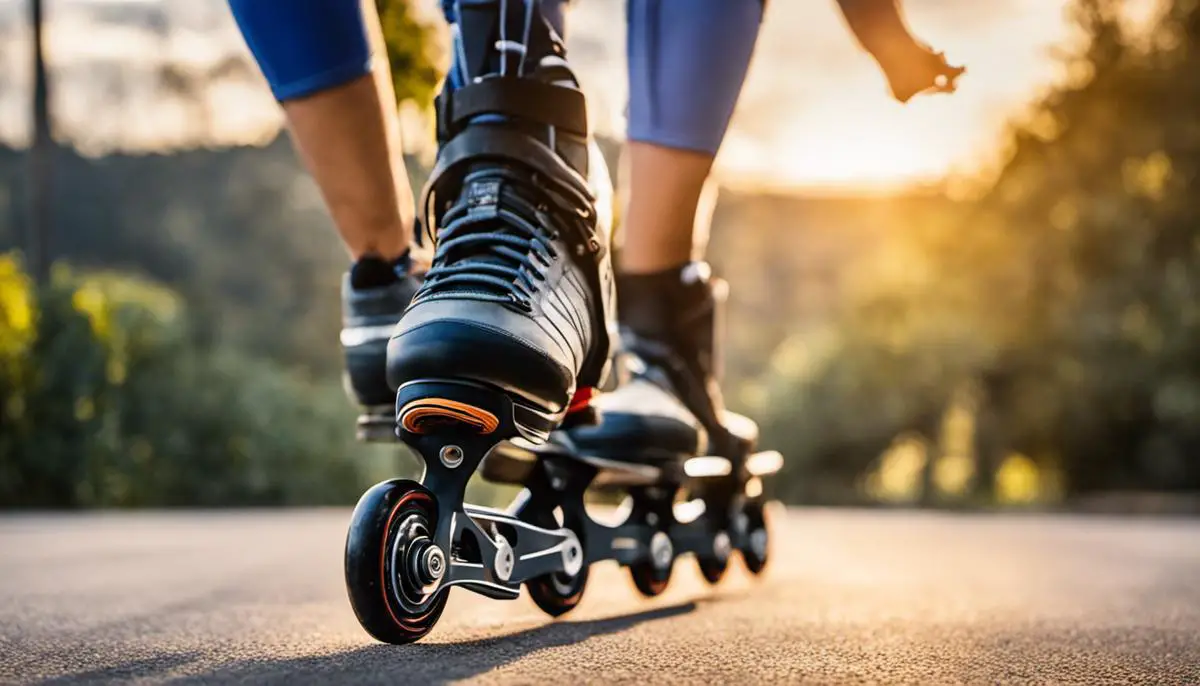Rollerblading, a fun and exhilarating sport, offers remarkable health benefits and serves as an outstanding workout option for those looking to burn calories efficiently. Beyond the thrill of coasting down streets or racing around a track, rollerblading engages various muscle groups in the body, enhancing metabolic function and ramping up calorie burn. In this discussion, we’ll dissect the fundamentals of rollerblading, scrutinize how its mechanics result in a sizzling calorie burn, and contrast its effectiveness against other popular exercises. Furthermore, we’ll provide indispensable tips for catalyzing calorie burn through specific rollerblading routines or tweaks, instilling an awareness of safety while enjoying this rewarding pastime.
Basics of Rollerblading and its Impact on Calorie Burning
Rollerblading, otherwise known as inline skating, is an excellent and enjoyable way to blast through calories—all while having a ton of fun! It’s no surprise to see that this activity shines bright as a top tier, calorie-burning outpatient. Indeed, rollerblading presents a potent combination of aerobic and anaerobic exercise that gives it an edge over many other sport hobbies when it comes to incinerating calories.
Unlike other cardiovascular workouts, rollerblading engages the whole body, although the lower half bears the brunt of the exertion. By employing the glutes, quadriceps, hamstrings, and calves, this venture becomes a whole-body workout, ensuring maximum calorie burning potential. Furthermore, the balancing act involved—the core and the upper body need to maintain stability—adds an extra element of muscle engagement, which as we all know, helps to increase the burn. On average, someone rollerblading at a moderate pace for an hour could burn between 300 and 600 calories, depending on their weight and the intensity of the workout. If speed skating is in play, even more calories could be shed in that hour!
Ultimately, rollerblading’s distinctive combination of full-body engagement, aerobic and anaerobic exertion, and high-speed potential make it a spectacularly-efficient calorie-burning pastime. Regardless if you’re out for a leisurely roll or practicing high-intensity speed skating drills, rollerblading offers an inclusive calorie-burning solution for anyone interested in this graceful and exciting hobby. So, if dropping calories is a goal, then let those wheels hit the road and let the good times roll!

Photo by muzammilo on Unsplash
Comparison of Calorie Burn from Rollerblading vs. Other Exercises
In comparison with other common forms of exercise, rollerblading holds its own when it comes to calorie burn.
A direct contrast with jogging, for instance, reveals an interesting edge.
Although jogging is widely recognized as an effective calorie burner- pertinent study confirms that a person skating at a moderate speed burns approximately the same amount of calories as if they were running at 5 miles per hour.
This does not mean jogging is less effective, but evidences the potency of rollerblading as a worthwhile alternative – one that is also typically lower in impact on the joints, making it a feasible option for those with certain physical limitations.
Cycling and swimming, on the other hand, are also popular choices for individuals desiring a full-body workout.
A comparison with rollerblading reveals they, too, deliver a commendable calorie burn, albeit via differing mechanics.
While biking primarily targets the lower body and swimming engages muscles universally, the calorie burn is typically less per hour than rollerblading at a similar intensity.
Generally, a moderate-to-brisk rollerblading session can burn between 400 to 750 calories per hour.
This surpasses both biking and swimming, which burn about 250-500 and 400-700 calories per hour, respectively, at a similar level of effort.
Therefore, don’t discount rollerblading! Its unique blend of fun, motion, and full-body engagement truly packs a fitness punch.

Tips to Maximize Calorie Burn during Rollerblading
One of the greatest things about rollerblading is that it’s easy to tweak and adapt the activity to suit one’s unique fitness goals. If the aim is to burn calories more effectively, there are several tactics to consider. For instance, interval training can work wonders in this area. This method involves alternating high-intensity and low-intensity rollerblading bursts for the duration of the workout session. With each challenging sprint, the heart rate soars, and a significant amount of energy is expended, leading to higher calorie burns even post-workout. Often, these are referred to as “afterburn” calories.
Different terrains used for rollerblading can also shape the overall calorie burn significantly. Flat, smooth surfaces require less effort and might be perfect for beginners or light, steady sessions. But tackling inclined paths or hilly areas can help elevate the workout complexity level. This, in turn, engages the body more intensely, requiring more energy – in other words, more calories burned. Additionally, to keep the calorie burn at its peak, it’s vital to master proper form. Keeping the body low and bending at the knees helps engage the thighs and glutes, those calorie-burning powerhouses. Incorporating arm movements can bring about an even more wholesome influence.
In conclusion, small tweaks in rollerblading practices such as interval training, changing terrains, maintaining proper form, engaging arm movements, and toughening up those thighs and glutes can maximize calorie burns. What’s more, sprucing up the rollerblading routine with these variations also keeps the activity exciting, while enhancing the fitness journey. And isn’t that what hobbies are all about, becoming the best version of ourselves while having heaps of fun?

Safety Considerations for Rollerblading
Safety precautions play a paramount role in ensuring an effective, injury-free rollerblading experience that optimizes calorie burn.
Prime among these precautions is wearing the appropriate protective gear.
A solid helmet will protect one’s noggin during any tumbles, while knee and elbow pads provide a shield against scrapes and bruising.
Wrist guards are essential too, as instinctive hand flinging during a trip or fall can lead to sprained or fractured wrists.
Therefore, combining this gear with a good pair of skates will guarantee an effective workout with minimized risk.
However, safety isn’t confined to protective gear.
The choice of environment significantly influences an individual’s safety during rollerblading.
Selecting smooth pavements or dedicated rollerblading paths over rocky terrains or traffic-filled roads will lead to lesser chances of accidents and uninterrupted, smooth gliding.
Rollerbladers should also watch out for obstacles, like rocks or sticks that may lead to nasty falls.
Furthermore, pacing oneself during rollerblading ensures the body gets ample time to adjust to the energy exertion, thus preventing any sudden strains or pulls.
Additionally, a well-hydrated body is less prone to heat exhaustion or dehydration, particularly during sunny weather.
Similarly, correct nutrition fuels the body for the high-energy workout and helps speed up the recovery process afterward.
All these factors interplay to make rollerblading not just safe but also an effective and fun way to burn those pesky calories.

Ensuring safety during rollerblading is paramount; it not only fosters a comfortable skating experience but significantly lowers the potential risks of injuries as well. From donning proper protective gear to abiding by traffic laws, all elements contributing to a safe rollerblading session should receive due attention. To experience the sport’s true potential – as a full-body workout, a fun leisure activity, or an effective calorie-burning exercise – one must stride ahead with both safety and effectiveness in mind and heart. If practiced correctly and safely, rollerblading can, indeed, be a game-changing addition to your fitness itinerary.
